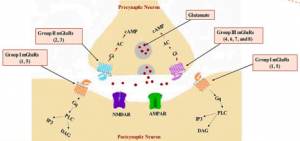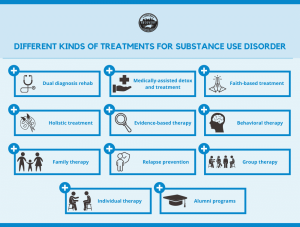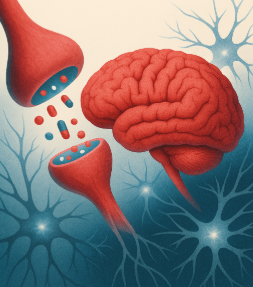Artstract created by Ren Lind
Society has stigmatized drug addiction, often blaming the person for going back to drugs. However, drugs alter the brain, so it’s harder to say no. Understanding the science behind addiction can help give a new understanding and greater empathy for those who are addicted to substances. Understanding the science may also help deter you from “just trying it once.” This article will specifically focus on psychostimulants: nicotine, methamphetamine, amphetamine, cocaine, NMDA, dextroamphetamine, and methylphenidate. We will also dive into some common treatment options for addiction.
Glutamate
Before we get into the science of how drug’s change the brain, let’s look at glutamate and its receptors at baseline, along with how drugs change their activity. Glutamate is one of the most influential neurotransmitters for drug addiction. Glutamate is the main excitatory neurotransmitter in the brain, in other words, it will elicit signals passing through neurons. It’s important for cognitive activities. [1]

Group 1 receptors will be on the postsynaptic neuron, and they are important for synaptic plasticity, or in other words, creating greater connections between neurons that will lead to stronger memory formation. When taking a drug, Group 1 glutamate receptors will activate drug-seeking behaviors, and an increased amount of glutamate will be released. [3] This will cause feelings associated with reward.
Group 2 glutamate receptors regulate glutamate release by decreasing the amount of glutamate released, so the feeling of reward is controlled. Group 2 can also decrease motivation for substance use. However, drugs decrease the activity of Group 2 receptors, so there is less regulation on glutamate, and therefore more feelings of reward and less motivation to stop drug use. [4] Drugs tamper the ability to stop using drug use.
A person addicted to drugs does not have a typical functioning brain, the drugs have removed protective measures in their brain that would help them stop drug use. This is why intervention and support are crucial for people addicted to substances.
Overview of Common Treatments
If someone you know, or you yourself, are struggling with drug addiction, there are resources for support. The most common form of treatment is various forms of therapy. [5] Initial medical detox is an important first step, and hospitalization or treatment facilities can help manage withdrawal symptoms and create a safe environment.

Another common practice is Contingency Management. This practice is not a therapy option, but it is often used alongside other treatment options. The client will receive rewards, such as gift cards or vouchers, for attending treatment sessions and negative urine tests. This practice has been found to be effective at helping encourage drug abstinence. [8] It uses the reward circuit commonly associated with drug behaviors to reward non-drug behaviors.
Lastly, community reinforcement encourages the client to create new social networks, find different recreational activities, and create a meaningful life outside of drugs. These therapies are some of the most common, but there is many other forms of treatment that can help someone with addictions.
As we’ve established, drugs make it much harder to stop drug use once it’s began. It’s not entirely the person’s fault that their brain has made stopping harder, but it’s never impossible to stop addiction.
Resources
[1-4] Mozafari, R., Karimi-Haghighi, S., Fattahi, M., Kalivas, P., Haghparast, A. (2022). A review on the role of metabotropic glutamate receptors in neuroplasticity following psychostimulant use disorder. Progress in Neuropsychopharmacology & Biological Psychiatry, 124. https://doi.org/10.1016/j.pnpbp.2023.110735
[5] Volkow, N. D., & Blanco, C. (2023). Substance use disorders: a comprehensive update of classification, epidemiology, neurobiology, clinical aspects, treatment and prevention. World psychiatry : official journal of the World Psychiatric Association (WPA), 22(2), 203–229. https://doi.org/10.1002/wps.21073
[6] https://carolinacenterforrecovery.com/wp-content/uploads/2020/05/different-kinds-of-treatments-for-substance-use-disorder-infographic.png
[7, 8] Volkow, N. D., & Blanco, C. (2023). Substance use disorders: a comprehensive update of classification, epidemiology, neurobiology, clinical aspects, treatment and prevention. World psychiatry : official journal of the World Psychiatric Association (WPA), 22(2), 203–229. https://doi.org/10.1002/wps.21073
